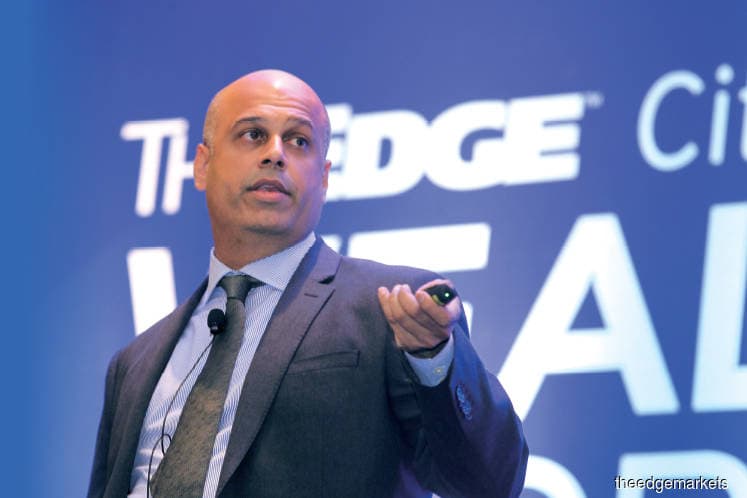
This article first appeared in Personal Wealth, The Edge Malaysia Weekly on March 4, 2019 - March 10, 2019
The ongoing US-China trade tensions impacted US equities last year. Nevertheless, Franklin Templeton continues to be optimistic about this asset class as corporate earnings are currently looking attractive, according to Subash Pillai, managing director and regional head of client investment solutions for Asia-Pacific at Franklin Templeton Multi-Asset Solutions.
In his presentation at The Edge-Citigold Wealth Forum 2019, entitled “Navigating macro challenges — Next steps in multi-asset investing”, Pillai said US earnings per share was expected to grow 7.8% this year and 10.5% in 2020. While the numbers are substantially lower than the 24.5% recorded last year, they can still be considered attractive, he added.
Franklin Templeton is positive that US corporate profit margins will continue to rise and sees this extending into 2019. Also, earnings expectations for the year are grounded, says Pillai. “Rising margins are a function of the tax cuts and increased weight of infotech. What is also important is that the US will benefit to a degree from a resolution of the trade war and that has the ability to potentially move these expectations further.”
Franklin Templeton has a neutral stance on emerging markets. Pillai said tightening global liquidity is a headwind for emerging markets and sees scope for earnings disappointment in 2019. Having said that, the firm does place importance on having emerging-market securities in investors’ portfolios.
“So, we are fairly neutral on emerging markets. To be clear, however, in our portfolios that we build for a lot of investors in the region, we have structurally overweighted [these markets] as a reflection of where we are and where we believe the long-term growth opportunities are,” said Pillai.
Franklin Templeton has been concerned about two areas for the last three to four years. The first is equities — whether the market will see another correction like the one in 2008 and how long the bull run can last. The second is the effect of rising interest rates on investors’ portfolios.
Against this backdrop, investors face the challenge of finding safe and low-risk options, which some believe lies in fixed-income and cash instruments. However, this strategy will not provide investors with enough returns to meet their long-term goals, said Pillai.
“It is unlikely that earning an average of 2.8% over the last 10 years in global bonds was sufficient to meet the long-term goals of most investors. Funding any consumption while growing capital ahead of inflation would require a far higher return than that,” he added.
The best one-year return that investors could have received from global stocks (from Dec 31, 2008 to Dec 31, 2018) was 35.4% while the lowest one-year return was -8.9%.
Taking this into consideration, investors should consider adopting a multi-asset strategy as it balances out the volatility of growth asset classes with the defensiveness that comes from bonds and cash, said Pillai. “We need to find a way to balance out these ‘safe’ asset classes with riskier ones. For us, it is the multi-asset approach that is crucial to solving this dilemma.”
Multi-asset funds saw moderate performances when the equity markets were falling. So, a multi-asset strategy would not solve the problem of falling stocks. But what it does is seriously mitigate it, said Pillai.
“In 1990, multi-asset funds fell 4.74% where equities fell 16.48%. If we look at 2008, the drawdowns were 42% for equity markets versus 23.27% for multi-assets,” he added.
“In 2018, we saw similar performance, although multi-asset strategies also had the challenge of US interest rate hikes lifting global bond rates. So, what you can have with a multi-asset approach is the ability to stay invested.”
On multi-asset funds in a rising interest rate environment, Pillai said it is great news for multi-asset portfolios as the returns are significantly higher than those of global bonds. “Rising rate environments tend to be associated with scenarios where you have an improving economy. So, you can have decent performance coming out of equities and credit in your portfolio.
“This is actually a great time to be invested in multi-asset funds. They do have fixed-income exposure, but the exposure and loss that will come from higher interest rates have been more than offset by the gains in equities and credit in virtually all historical cases.”
Save by subscribing to us for your print and/or digital copy.
P/S: The Edge is also available on Apple's AppStore and Androids' Google Play.